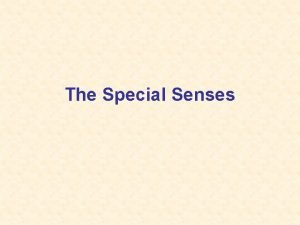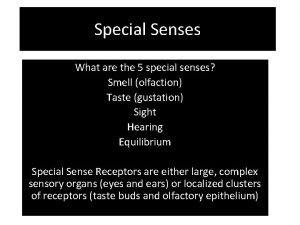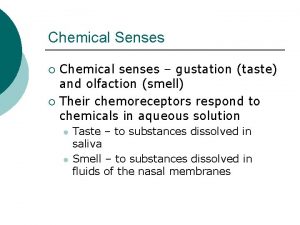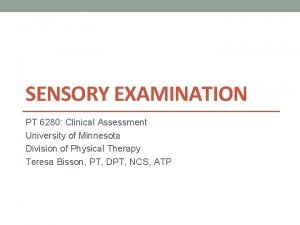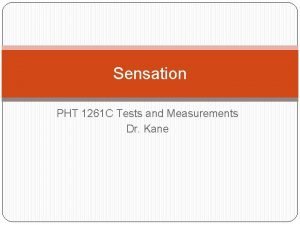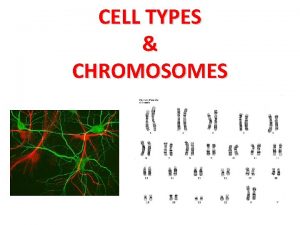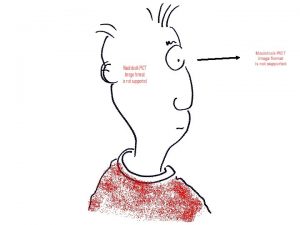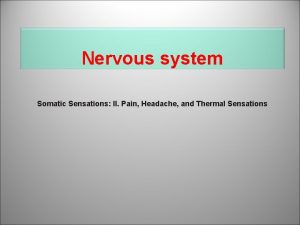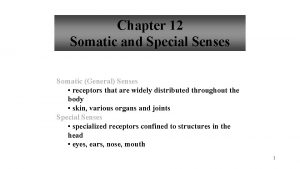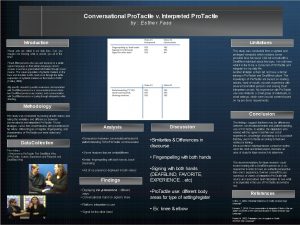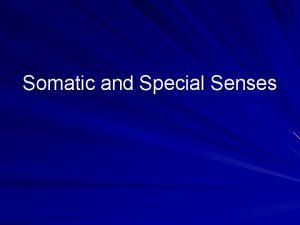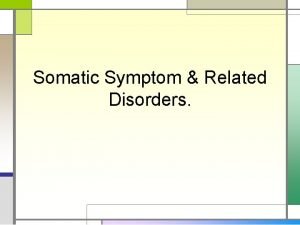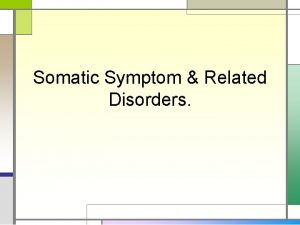Somatic Sensations I General Organization the Tactile and














- Slides: 14

Somatic Sensations: I. General Organization, the Tactile and Position Senses

Somatic senses The somatic senses are the nervous mechanisms that collect sensory information from all over the body. These senses are in contradistinction to the special senses, which mean specifically vision, hearing, smell, taste, and equilibrium.

Classifications of somatic sensations • Mechanoreceptive somatic senses, which include both tactile and position sensations that are stimulated by mechanical displacement of some tissue of the body • Thermoreceptive senses, which detect heat and cold • Pain sense, which is activated by any factor that damages the tissues. Exteroreceptive sensations Proprioceptive sensations Visceral sensations Deep sensations

Detection and Transmission of Tactile Sensations • Touch pressure and vibration are detected by the same type of receptors – touch sensation generally results from stimulation of tactile receptors in the skin or in tissues immediately beneath the skin – pressure sensation generally results from deformation of deeper tissues; – vibration sensation results from rapidly repetitive sensory signals, but some of the same types of receptors as those for touch and pressure are used.

Tactile Receptors • Free nerve endings, • Meissner’s corpuscle • Expanded tip tactile receptors, – one type of which is Merkel’s discs, • • Iggo dome receptor, Hair end-organ, Ruffini’s end-organs, Pacinian corpuscles,

Transmission of Tactile Signals in Peripheral Nerve Fibers Critical signal, faster nerve fiber transmission Crude signal, tickle, slow transmission fiber

Sensory Pathways for Transmitting Somatic Signals into the Central Nervous System • Dorsal root of the spinal nerves – the dorsal column–medial lemniscal system – the anterolateral system. – These two systems come back together partially at the level of the thalamus • signals in the anterolateral system, immediately after entering the spinal cord from the dorsal spinal gray matter, then cross to the opposite side of the cord and ascend through the anterio all levels of the lower brain stem and in the thalamus. • smaller myelinated fibers that transmit signals at velocities ranging from a few meters per sec • Information that which does not need to be transmitted rapidly or with great spatial fidelity is

Transmission in the Dorsal Column– Medial Lemniscal System Dorsal Column–Medial Lemniscal System 1. Touch sensations requiring a high degree of localization of the stimulus 2. Touch sensations requiring transmission of fine gradations of intensity 3. Phasic sensations, such as vibratory sensations 4. Sensations that signal movement against the skin 5. Position sensations from the joints 6. Pressure sensations having to do with fine degrees of judgment of pressure intensity Anterolateral System 1. Pain 2. Thermal sensations, including both warmth and cold sensations 3. Crude touch and pressure sensations capable only of crude localizing ability on the surface of the body 4. Tickle and itch sensations 5. Sexual sensations

Transmission in the Dorsal Column– Medial Lemniscal System

Spatial Orientation of the Nerve Fibers in the Dorsal Column-Medial Lemniscal System Somatosensory cortex




Functions of Somatosensory Area I • The person is unable to localize discretely the different sensations in the different parts of the body. However, he or she can localize these sensations crudely, such as to a particular hand, to a major level of the body trunk, or to one of the legs. Thus, it is clear that the brain stem, thalamus, or parts of the cerebral cortex not normally considered to be concerned with somatic sensations can perform some degree of localization. • The person is unable to judge critical degrees of pressure against the body. • The person is unable to judge the weights of objects. • The person is unable to judge shapes or forms of objects. This is called astereognosis. • The person is unable to judge texture of materials because this type of judgment depends on highly critical sensations caused by movement of the fingers over the surface to be judged.
 To study inner sensations images and feelings
To study inner sensations images and feelings Five basic taste sensations
Five basic taste sensations 5 special senses
5 special senses Physical sensations examples
Physical sensations examples Primary taste sensations
Primary taste sensations Chapter 6 sensation and perception
Chapter 6 sensation and perception Five basic taste sensations
Five basic taste sensations Cortical sensations
Cortical sensations Cortical sensations
Cortical sensations Perception in psychology
Perception in psychology Difference between fine touch and crude touch
Difference between fine touch and crude touch Block comparison vs point by point
Block comparison vs point by point Chapter 10 somatic and special senses
Chapter 10 somatic and special senses Chapter 29 somatic symptom and dissociative disorders
Chapter 29 somatic symptom and dissociative disorders Diploid cell
Diploid cell

